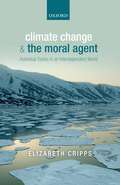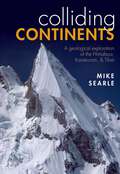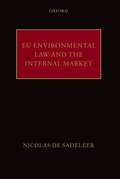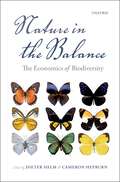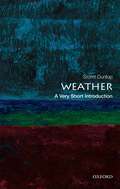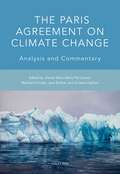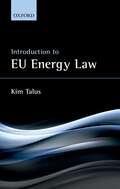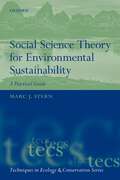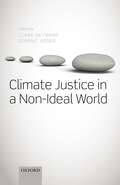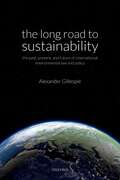- Table View
- List View
Environmental Politics: From Margins To Mainstream (Very Short Introductions)
by Andrew DobsonEnvironmental politics has many faces and operates at multiple scales: it preoccupies individuals as well as governments, drives local agreements as well as international treaties, results in minor business changes as well as wholesale business decisions, and fluctuates between a politics of protest and one of accommodation. In this Very Short Introduction Andrew Dobson offers a lively and comprehensive commentary on the many facets of environmental politics today. Looking towards the future, he asks whether environmental politics will be comfortably accommodated by mainstream politics, or whether the advent of the Anthropocene - a whole new geological epoch driven by human impact on the environment - will herald a break with the politics of growth that has dominated social life since the beginning of the Industrial Revolution. ABOUT THE SERIES: The Very Short Introductions series from Oxford University Press contains hundreds of titles in almost every subject area. These pocket-sized books are the perfect way to get ahead in a new subject quickly. Our expert authors combine facts, analysis, perspective, new ideas, and enthusiasm to make interesting and challenging topics highly readable.
Climate Change And The Moral Agent: Individual Duties In An Interdependent World
by Elizabeth CrippsMany of us take it for granted that we ought to cooperate to tackle climate change. But where does this requirement come from and what does it mean for us as individuals trying to do the right thing? Although climate change does untold harm to our fellow humans and to the non-human world, no one causes it on their own and it is not the result of intentionally collective action. In the face of the current failure of institutions to confront the problem, is there anything we can do as individuals that will leave us able to live with ourselves? This book responds to these challenges. It makes a moral case for collective action on climate change by appealing to moralized collective self-interest, collective ability to aid, and an expanded understanding of collective responsibility for harm. It also argues that collective action is something we owe to ourselves, as moral agents, because without it we are left facing marring choices. In the absence of collective action, individuals should focus on trying to promote such action (whether through or by bypassing existing institutions), with a supplementary duty to aid victims directly. The argument is not that we should not be cutting our own emissionsthis can be a vital part of bringing about collective action or alleviating harmbut that such `green lifestyle choices cannot straightforwardly be defended as duties in their own right, and should not take priority over trying to bring about collective change.
The Natural History of Selborne
by Anne Secord'I was much entertained last summer with a tame bat, which would take flies out of a person's hand.' Gilbert White's Natural History of Selborne (1789) reveals a world of wonders in nature. Over a period of twenty years White describes in minute detail the behaviour of animals through the changing seasons in the rural Hampshire parish of Selborne. He notes everything from the habits of an eccentric tortoise to the mysteries of bird migration and animal reproduction, with the purpose of inspiring others to observe their own surroundings with the same pleasure and attention. Written as a series of letters, White's book has all the immediacy of an exchange with friends, yet it is crafted with compelling literary skill. His gossipy correspondence has delighted readers from Charles Darwin to Virginia Woolf, and it has been read as a nostalgic evocation of a pastoral vision, a model for local studies of plants and animals, and a precursor to modern ecology. This new edition includes contemporary illustrations, a contextualizing introduction, and an appendix of literary responses to the book. ABOUT THE SERIES: For over 100 years Oxford World's Classics has made available the widest range of literature from around the globe. Each affordable volume reflects Oxford's commitment to scholarship, providing the most accurate text plus a wealth of other valuable features, including expert introductions by leading authorities, helpful notes to clarify the text, up-to-date bibliographies for further study, and much more.
Colliding Continents: A Geological Exploration Of The Himalaya, Karakoram, And Tibet
by Mike SearleThe crash of the Indian plate into Asia is the biggest known collision in geological history, and it continues today. The result is the Himalaya and Karakoram - one of the largest mountain ranges on Earth. The Karakoram has half of the world's highest mountains and a reputation as being one of the most remote and savage ranges of all. In this beautifully illustrated book, Mike Searle, a geologist at the University of Oxford and one of the most experienced field geologists of our time, presents a rich account of the geological forces that were involved in creating these mountain ranges. Using his personal accounts of extreme mountaineering and research in the region, he pieces together the geological processes that formed such impressive peaks.
EU Environmental Law and the Internal Market
by Nicolas de SadeleerFor some, a protectionist policy underlies most environmental measures. Lawyers working in the area of fundamental freedoms are very accustomed to discussing all issues within a free market framework and therefore often come to market-friendly decisions. Similarly, while environmental law has taken on a renewed intensity at European level, the tendency has been to analyse the subject rather narrowly, and studies fail to address the impact of environmental law on market integration. Written by one of the foremost experts in the area, the book challenges current thought and re-assesses the rules of economic integration within an environmental framework. In so doing, it bridges the gap between environmental and trade law and provides a systematic, robust, and practically workable analytical framework of the conflicts opposing rapidly evolving environmental and climate change measures and internal market as well as competition rules. The book is divided into three parts, beginning with a systematic and in-depth analysis of the key Treaty provisions regarding environmental protection, as well as an overview of secondary environmental law. Part two addresses the compatibility of EU and national environmental protection measures with the provisions of the TFEU on the free movement of goods and services, and the freedom of establishment. Part three examines the compatibility of environmental protection measures with treaty provisions on the freedom of competition and State aids. The book also includes discussion of all major cases handed down by the Court of Justice, highlighting the real impact of the conflicts.
EU Environmental Law and the Internal Market
by Nicolas De SadeleerFor some, a protectionist policy underlies most environmental measures. Lawyers working in the area of fundamental freedoms are very accustomed to discussing all issues within a free market framework and therefore often come to market-friendly decisions. Similarly, while environmental law has taken on a renewed intensity at European level, the tendency has been to analyse the subject rather narrowly, and studies fail to address the impact of environmental law on market integration. Written by one of the foremost experts in the area, the book challenges current thought and re-assesses the rules of economic integration within an environmental framework. In so doing, it bridges the gap between environmental and trade law and provides a systematic, robust, and practically workable analytical framework of the conflicts opposing rapidly evolving environmental and climate change measures and internal market as well as competition rules. The book is divided into three parts, beginning with a systematic and in-depth analysis of the key Treaty provisions regarding environmental protection, as well as an overview of secondary environmental law. Part two addresses the compatibility of EU and national environmental protection measures with the provisions of the TFEU on the free movement of goods and services, and the freedom of establishment. Part three examines the compatibility of environmental protection measures with treaty provisions on the freedom of competition and State aids. The book also includes discussion of all major cases handed down by the Court of Justice, highlighting the real impact of the conflicts.
Nature In The Balance: The Economics Of Biodiversity
by Dieter Helm Cameron HepburnThis book sets out the building blocks of an economic approach to biodiversity, and in particular brings together conceptual and empirical work on valuation, international agreements, the policy instruments, and the institutions. The objective is to provide a comprehensive overview of the issues and evidence, and to suggest how this very urgent problem should be addressed. Whilst there has been an enormous growth and research focus on climate change, less attention has been paid to biodiversity. This collection of high-quality chapters addresses the economic issues involved in biodiversity protection. This book focuses on the economics, but incorporates the underpinning science and philosophy, combining the application of a number of theoretical ideas with a series of policy cases. The authors are drawn from leading scholars in their specific areas of economics, philosophy, and conservation biology.
Weather: A Very Short Introduction (Very Short Introductions)
by Storm DunlopFrom deciding the best day for a picnic, to the devastating effects of hurricanes and typhoons, the weather impacts our lives on a daily basis. Although new techniques allow us to forecast the weather with increasing accuracy, most people do not realise the vast global movements and forces which result in their day-to-day weather. In this Very Short Introduction Storm Dunlop explains what weather is and how it differs from climate, discussing what causes weather, and how we measure it. Analysing the basic features and properties of the atmosphere, he shows how these are directly related to the weather experienced on the ground, and to specific weather phenomena and extreme weather events. He describes how the global patterns of temperature and pressure give rise to the overall circulation within the atmosphere, the major wind systems, and the major oceanic currents, and how features such as mountains and the sea affect local weather. He also looks at examples of extreme and dangerous weather, such as of tropical cyclones (otherwise known as hurricanes and typhoons), describing how 'Hurricane Hunters' undertake the dangerous task of flying through them. We measure weather in a number of ways: observations taken on the land and sea; observations within the atmosphere; and measurements from orbiting satellites. Dunlop concludes by looking at how these observations have been used to develop increasingly sophisticated long- and short-range weather forecasting, including ensemble forecasting. ABOUT THE SERIES: The Very Short Introductions series from Oxford University Press contains hundreds of titles in almost every subject area. These pocket-sized books are the perfect way to get ahead in a new subject quickly. Our expert authors combine facts, analysis, perspective, new ideas, and enthusiasm to make interesting and challenging topics highly readable.
Weather: Spectacular Images Of The World's Extraordinary Climate (Very Short Introductions)
by Storm DunlopFrom deciding the best day for a picnic, to the devastating effects of hurricanes and typhoons, the weather impacts our lives on a daily basis. Although new techniques allow us to forecast the weather with increasing accuracy, most people do not realise the vast global movements and forces which result in their day-to-day weather. In this Very Short Introduction Storm Dunlop explains what weather is and how it differs from climate, discussing what causes weather, and how we measure it. Analysing the basic features and properties of the atmosphere, he shows how these are directly related to the weather experienced on the ground, and to specific weather phenomena and extreme weather events. He describes how the global patterns of temperature and pressure give rise to the overall circulation within the atmosphere, the major wind systems, and the major oceanic currents, and how features such as mountains and the sea affect local weather. He also looks at examples of extreme and dangerous weather, such as of tropical cyclones (otherwise known as hurricanes and typhoons), describing how 'Hurricane Hunters' undertake the dangerous task of flying through them. We measure weather in a number of ways: observations taken on the land and sea; observations within the atmosphere; and measurements from orbiting satellites. Dunlop concludes by looking at how these observations have been used to develop increasingly sophisticated long- and short-range weather forecasting, including ensemble forecasting. ABOUT THE SERIES: The Very Short Introductions series from Oxford University Press contains hundreds of titles in almost every subject area. These pocket-sized books are the perfect way to get ahead in a new subject quickly. Our expert authors combine facts, analysis, perspective, new ideas, and enthusiasm to make interesting and challenging topics highly readable.
The Paris Agreement on Climate Change: Analysis and Commentary
The most important climate agreement in history, the Paris Agreement on Climate Change represents the commitment of the nations of the world to address and curb climate change. Signed in December 2015, it entered into force on 4th November 2016. Countries are moving into implementation, and efforts at all levels will be needed to fulfill its ambitious goals. The Paris Climate Agreement: Commentary and Analysis combines a comprehensive legal appraisal and critique of the new Agreement with a practical and structured commentary to and social drivers behind it, providing an overview of the pre-existing regime, and tracking the history of the negotiations. It examines the evolution of key concepts such as common but differentiated responsibilities, and analyses the legal form of the Agreement and the nature of its provisions. Part II comprises individual chapters on each Article of the Agreement, with detailed commentary of the provisions which highlights central aspects from the negotiating history and the legal nature of the obligations. It describes the institutional arrangements and considerations for national implementation, providing practical advice and prospects for future development. Part III reflects on the Paris Agreement as a whole: its strengths and weaknesses, its potential for further development, and its relationship with other areas of public international law and governance. The book is an invaluable resource for academics and practitioners, policy makers, and actors in the private sector and civil society, as they negotiate the implementation of the Agreement in domestic law and policy.
The Paris Agreement on Climate Change: Analysis and Commentary
by Daniel Klein, María Pía Carazo, Meinhard Doelle, Jane Bulmer, and Andrew HighamThe most important climate agreement in history, the Paris Agreement on Climate Change represents the commitment of the nations of the world to address and curb climate change. Signed in December 2015, it entered into force on 4th November 2016. Countries are moving into implementation, and efforts at all levels will be needed to fulfill its ambitious goals. The Paris Climate Agreement: Commentary and Analysis combines a comprehensive legal appraisal and critique of the new Agreement with a practical and structured commentary to and social drivers behind it, providing an overview of the pre-existing regime, and tracking the history of the negotiations. It examines the evolution of key concepts such as common but differentiated responsibilities, and analyses the legal form of the Agreement and the nature of its provisions. Part II comprises individual chapters on each Article of the Agreement, with detailed commentary of the provisions which highlights central aspects from the negotiating history and the legal nature of the obligations. It describes the institutional arrangements and considerations for national implementation, providing practical advice and prospects for future development. Part III reflects on the Paris Agreement as a whole: its strengths and weaknesses, its potential for further development, and its relationship with other areas of public international law and governance. The book is an invaluable resource for academics and practitioners, policy makers, and actors in the private sector and civil society, as they negotiate the implementation of the Agreement in domestic law and policy.
Introduction to EU Energy Law
by Kim TalusOffering an introduction to students on the most essential elements of EU energy law and policy, this volume will be the go-to text for those seeking knowledge of EU energy regulation and its objectives, as well as an overview of energy law. Specific topics will cover the content of sector-specific energy regulation, the application and impact of general EU law on energy markets, third party access, unbundling, investment in cross-border networks, energy trading and market supervision, the application of general EU competition law on energy markets, the impact of free movement provisions, and the application of state aid rules. A structured, step by step guide through the fundamental areas of EU energy law.
Introduction to EU Energy Law
by Kim TalusOffering an introduction to students on the most essential elements of EU energy law and policy, this volume will be the go-to text for those seeking knowledge of EU energy regulation and its objectives, as well as an overview of energy law. Specific topics will cover the content of sector-specific energy regulation, the application and impact of general EU law on energy markets, third party access, unbundling, investment in cross-border networks, energy trading and market supervision, the application of general EU competition law on energy markets, the impact of free movement provisions, and the application of state aid rules. A structured, step by step guide through the fundamental areas of EU energy law.
Social Science Theory for Environmental Sustainability: A Practical Guide (Techniques in Ecology & Conservation)
by Marc J. SternSocial-ecological challenges call for a far better integration of the social sciences into conservation training and practice. Environmental problems are, first and foremost, people problems. Without better understandings of the people involved, solutions are often hard to come by, regardless of expertise in biology, ecology, or other traditional conservation sciences. This novel book provides an accessible survey of a broad range of theories widely applicable to environmental problems that students and practitioners can apply to their work. It serves as a simple reference guide to illuminate the value and utility of social science theories for the practice of environmental conservation. As part of the Techniques in Ecology and Conservation Series, it will be a vital resource for conservation scientists, students, and practitioners to better navigate the social complexities of applying their work to real-world problem-solving.
Environmental Law: A Very Short Introduction (Very Short Introductions)
by Elizabeth FisherEnvironmental law is the law concerned with environmental problems. It is a vast area of law that operates from the local to the global, involving a range of different legal and regulatory techniques. In theory, environmental protection is a no brainer. Few people would actively argue for pollution or environmental destruction. Ensuring a clean environment is ethically desirable, and also sensible from a purely self-interested perspective. Yet, in practice, environmental law is a messy and complex business fraught with conflict. Whilst environmental law is often characterized in overly simplistic terms, with a law being seen as be a magic wand that solves an environmental problem, the reality is that creating and maintaining a body of laws to address and avoid problems is not easy, and involves legislators, courts, regulators and communities. This Very Short Introduction provides an overview of the main features of environmental law, and discusses how environmental law deals with multiple interests, socio-political conflicts, and the limits of knowledge about the environment. Showing how interdependent societies across the world have developed robust and legitimate bodies of law to address environmental problems, Elizabeth Fisher discusses some of the major issues involved in environmental law's: nation statehood, power, the reframing role of law, the need to ensure real environmental improvements, and environmental justice. As Fisher explains, environmental law is, and will always be, necessary but inherently controversial. ABOUT THE SERIES: The Very Short Introductions series from Oxford University Press contains hundreds of titles in almost every subject area. These pocket-sized books are the perfect way to get ahead in a new subject quickly. Our expert authors combine facts, analysis, perspective, new ideas, and enthusiasm to make interesting and challenging topics highly readable.
Environmental Law: Text, Cases And Materials (Very Short Introductions)
by Elizabeth FisherEnvironmental law is the law concerned with environmental problems. It is a vast area of law that operates from the local to the global, involving a range of different legal and regulatory techniques. In theory, environmental protection is a no brainer. Few people would actively argue for pollution or environmental destruction. Ensuring a clean environment is ethically desirable, and also sensible from a purely self-interested perspective. Yet, in practice, environmental law is a messy and complex business fraught with conflict. Whilst environmental law is often characterized in overly simplistic terms, with a law being seen as be a magic wand that solves an environmental problem, the reality is that creating and maintaining a body of laws to address and avoid problems is not easy, and involves legislators, courts, regulators and communities. This Very Short Introduction provides an overview of the main features of environmental law, and discusses how environmental law deals with multiple interests, socio-political conflicts, and the limits of knowledge about the environment. Showing how interdependent societies across the world have developed robust and legitimate bodies of law to address environmental problems, Elizabeth Fisher discusses some of the major issues involved in environmental law's: nation statehood, power, the reframing role of law, the need to ensure real environmental improvements, and environmental justice. As Fisher explains, environmental law is, and will always be, necessary but inherently controversial. ABOUT THE SERIES: The Very Short Introductions series from Oxford University Press contains hundreds of titles in almost every subject area. These pocket-sized books are the perfect way to get ahead in a new subject quickly. Our expert authors combine facts, analysis, perspective, new ideas, and enthusiasm to make interesting and challenging topics highly readable.
Climate Justice in a Non-Ideal World
by Dominic Roser Clare HeywardClimate change is a pressing international political issue, for which a practical but principled solution is urgently required. Climate Justice in a Non-Ideal World aims to make normative theorising on climate justice more relevant and applicable to political realities and public policy. The motivation behind this edited collection is that normative theorising has something to offer even in an imperfect world mired by partial compliance and unfavourable circumstances. In the last years, a lively debate has sprung up in political philosophy about non-ideal theory and there has also been an upsurge of interest in the various normative issues raised by climate change such as intergenerational justice, transnational harm, collective action, or risk assessment. However, there has been little systematic discussion of the links between climate justice and non-ideal theory even though the former would seem like a paradigm example of the relevance of the latter. The aim of this edited volume is to address this. In doing so, the volume presents original work from leading experts on climate ethics, including several who have participated in climate policy. The first part of the book discusses those facets of the debate on climate justice that become relevant due to the shortcomings of current global action on climate change. The second part makes specific suggestions for adjusting current policies and negotiating procedures in ways that are feasible in the relatively short term while still decreasing the distance between current climate policy and the ideal. The chapters in the third and final part reflect upon how philosophical work can be brought to bear on the debates in climate science, communication, and politics.
Natural Resources and Human Rights: An Appraisal
by Jérémie GilbertNatural resources and their effective management are necessary for securing the realisation of human rights. The management of natural resources is linked to broad issues of economic development, as well as to political stability, peace and security, but it is also intimately connected to the political, economic, social and cultural rights of individuals and communities relying on these resources. The management of natural resources often leads to ill-planned development, misappropriation of land, corruption, bad governance, misaligned budget priorities, lack of strong institutional reforms and weak policies coupled with a continued denial of the human rights of local communities. This book argues that human rights law can play an important role in ensuring a more effective and sustainable management of natural resources, putting forward the idea of a human rights-based normative framework for natural resource management. It offers a comprehensive analysis of the different norms, procedures, and approaches developed under human rights law that are relevant to the management of natural resources. Advocating for a less market and corporate approach to the control, ownership, and management of natural resources, this book supports the development of holistic and coherent integration of human rights law in the overall international legal framework governing the management of natural resources.
Natural Resources and Human Rights: An Appraisal
by Jérémie GilbertNatural resources and their effective management are necessary for securing the realisation of human rights. The management of natural resources is linked to broad issues of economic development, as well as to political stability, peace and security, but it is also intimately connected to the political, economic, social and cultural rights of individuals and communities relying on these resources. The management of natural resources often leads to ill-planned development, misappropriation of land, corruption, bad governance, misaligned budget priorities, lack of strong institutional reforms and weak policies coupled with a continued denial of the human rights of local communities. This book argues that human rights law can play an important role in ensuring a more effective and sustainable management of natural resources, putting forward the idea of a human rights-based normative framework for natural resource management. It offers a comprehensive analysis of the different norms, procedures, and approaches developed under human rights law that are relevant to the management of natural resources. Advocating for a less market and corporate approach to the control, ownership, and management of natural resources, this book supports the development of holistic and coherent integration of human rights law in the overall international legal framework governing the management of natural resources.
Birnie, Boyle, and Redgwell's International Law and the Environment
by Alan Boyle Catherine RedgwellThe development of modern international environmental law has been one of the most remarkable exercises in international law-making. Although far more law and policy exists in this area than a quarter of a century ago, the global environment is in a much worse state: challenges remain in relation to the poor health of the oceans, climate change, the growing loss of biodiversity and ecosystems, and the other effects of human mismanagement of our global ecosystem, including global pandemics. As conservation of the environment plays an increasingly important role within society, Birnie, Boyle, and Redgwell's International Law and the Environment continues to be an essential read for students and practitioners alike. Written by experts in the field Birnie, Boyle, and Redgwell's International Law and the Environment places legislation on the protection of the environment firmly at the core of the text, while remaining rooted in the substantive law. The authors employ sharp and thorough analysis of the law, allowing them to share their extensive knowledge and experience with the reader. They provide a unique perspective on the implications of international regulation, promoting a wider understanding of the pertinent issues impacting upon the law. Digital formats and resources The fourth edition is available for students and institutions to purchase in a variety of formats. - The e-book offers a mobile experience and convenient access along with functionality tools and navigation features: www.oxfordtextbooks.co.uk/ebooks
Environmental Law: Text, Cases & Materials (Text, Cases, and Materials)
by Elizabeth Fisher Bettina Lange Eloise ScotfordEnvironmental Law: Text, Cases, and Materials has been designed to provide students with everything they need to approach the subject with confidence. Experts in the area, the authors combine clear and insightful commentary with carefully chosen extracts from UK and international sources to offer students a well-rounded view of the subject area. Covering a broad range of topics, the authors introduce discussion on controversies and debates and encourage readers to engage in critical reflection by posing regular discussion questions throughout the text. Further reading suggestions point students towards useful resources, guiding their independent research. Online Resources This book is also accompanied by online updates collated by the authors, helping students to stay well-informed.
Environmental Law: Text, Cases & Materials (Text, Cases, and Materials)
by Bettina Lange Eloise Scotford Elizabeth FisherEnvironmental Law: Text, Cases, and Materials has been designed to provide students with everything they need to approach the subject with confidence. Experts in the area, the authors combine clear and insightful commentary with carefully chosen extracts from UK and international sources to offer students a well-rounded view of the subject area. Covering a broad range of topics, the authors introduce discussion on controversies and debates and encourage readers to engage in critical reflection by posing regular discussion questions throughout the text. Further reading suggestions point students towards useful resources, guiding their independent research. Online Resources This book is also accompanied by online updates collated by the authors, helping students to stay well-informed.
Energy Systems: A Very Short Introduction (Very Short Introductions)
by Nick JenkinsModern societies require energy systems to provide energy for cooking, heating, transport, and materials processing, as well as for electricity generation. Energy systems include the primary fuel, its conversion, and transport to the point of use. In many cases this primary fuel is still a fossil fuel, a one-use resource derived from a finite supply within our planet, causing considerable damage to the environment. After 300 years of increasing reliance on fossil fuels, particularly coal, it is becoming ever clearer that the present energy systems need to change. In this Very Short Introduction Nick Jenkins explores our historic investment in the exploitation of fossil energy resources and their current importance, and discusses the implications of our increasing rate of energy use. He considers the widespread acceptance by scientists and policy makers that our energy systems must reduce emissions of CO2 and other greenhouse gases, and looks forward to the radical changes in fuel technology that will be necessary to continue to provide energy supplies in a sustainable manner, and extend access across the developing world. Considering the impact of changing to an environmentally benign and low-carbon energy system, Jenkins also looks at future low-carbon energy systems which would use electricity from a variety of renewable energy sources, as well as the role of nuclear power in our energy use. ABOUT THE SERIES: The Very Short Introductions series from Oxford University Press contains hundreds of titles in almost every subject area. These pocket-sized books are the perfect way to get ahead in a new subject quickly. Our expert authors combine facts, analysis, perspective, new ideas, and enthusiasm to make interesting and challenging topics highly readable.
Energy Systems: Connection And System Operational Aspects (Very Short Introductions #50)
by Nick JenkinsModern societies require energy systems to provide energy for cooking, heating, transport, and materials processing, as well as for electricity generation. Energy systems include the primary fuel, its conversion, and transport to the point of use. In many cases this primary fuel is still a fossil fuel, a one-use resource derived from a finite supply within our planet, causing considerable damage to the environment. After 300 years of increasing reliance on fossil fuels, particularly coal, it is becoming ever clearer that the present energy systems need to change. In this Very Short Introduction Nick Jenkins explores our historic investment in the exploitation of fossil energy resources and their current importance, and discusses the implications of our increasing rate of energy use. He considers the widespread acceptance by scientists and policy makers that our energy systems must reduce emissions of CO2 and other greenhouse gases, and looks forward to the radical changes in fuel technology that will be necessary to continue to provide energy supplies in a sustainable manner, and extend access across the developing world. Considering the impact of changing to an environmentally benign and low-carbon energy system, Jenkins also looks at future low-carbon energy systems which would use electricity from a variety of renewable energy sources, as well as the role of nuclear power in our energy use. ABOUT THE SERIES: The Very Short Introductions series from Oxford University Press contains hundreds of titles in almost every subject area. These pocket-sized books are the perfect way to get ahead in a new subject quickly. Our expert authors combine facts, analysis, perspective, new ideas, and enthusiasm to make interesting and challenging topics highly readable.
The Long Road to Sustainability: The Past, Present, and Future of International Environmental Law and Policy
by Alexander GillespieFor the last few thousand years, humanity has struggled to achieve sustainable development. Gillespie sees the problem as multi-faceted: a three legged stool of economic, social, and environmental conundrums have stalled the quest for the long term viability of both our species and the ecosystems in which we reside. Gillespie moves from the low life expectancy, excessive deforestation, and wetland drainage of the medieval period, through the species loss, coal burning, free trade, and poor waste management of the seventeenth and eighteenth centuries, and to the more recent concerns of climate change, unsustainable fisheries, and chemical pollutants. By delivering a comprehensive examination of human survival over the past millennium, Gillespie illustrates that the challenges we face are not new - that we now have the means to counter them, is.

